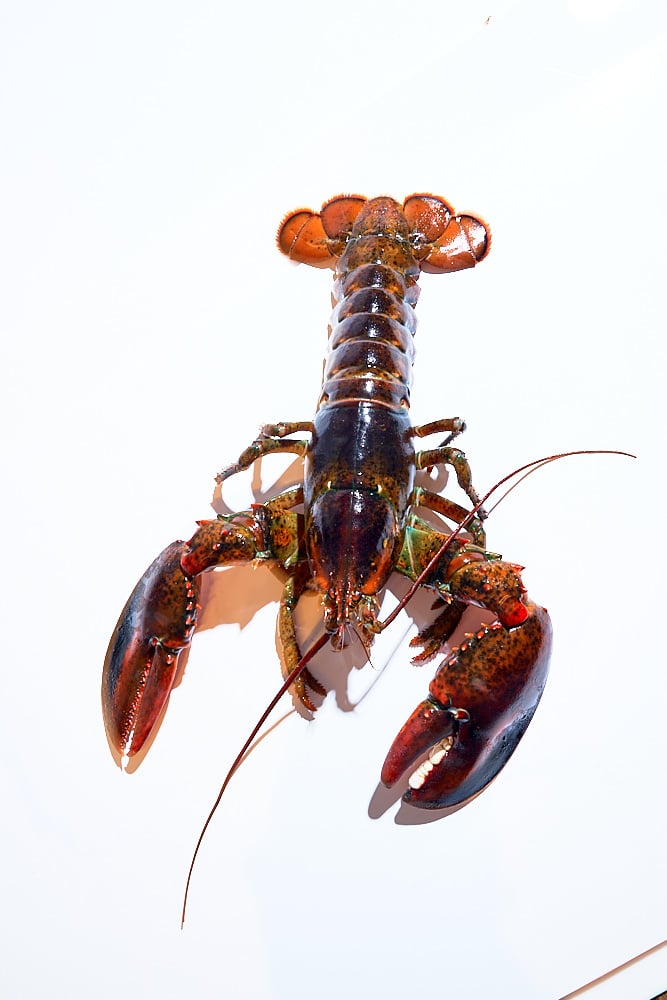By Virginia M. Wright
Photographed by Mark Fleming
From our July 2020 issue
1. Tail
Can I eat it? As if you could resist! This is the star attraction of your shore dinner. Some aficionados, including me, prefer the tail’s beefy texture to that of the soft claws.
How? Twist the tail until it pulls loose from the body. Pry out the meat with a fork.
Dedication level? A cinch. You get a lot of meat for little effort. Don’t forget the tail fins: bend them upward until they snap off to find tasty tidbits inside.

2. Claws
Can I eat them? Of course. The claws are costars. The meat is sweet and silky.
How? Twist the claw from the body, crack it open with a nutcracker, and coax the meat out with a cocktail fork. Try to extract it without tearing it — that and a goofy bib will mark you as a tourist.
Dedication level? Easy, especially if your lobster has a soft shell, which you can practically peel with your fingers.
3. Knuckles
Can I eat them? Some chefs say the chewy knuckles are the tastiest parts, but I suspect they’re just doing PR for a visually unimpressive lump of lobster.
How? The knuckle is the segment that attaches the claw to the body (the entire appendage is actually a leg, which makes this joint, called the carpus, more like a knee than a knuckle). Twist it from the claw and nudge the meat out with a seafood pick or your pinky.
Dedication level? Moderate. The knuckle shell is spiny, so it’s tough to grip, and you end up with a nugget the size of a grape.
4. Legs
Can I eat them? Sure, good meat in there.
How? Tear off a leg, bite down on the shell, and squeeze the meat out with your teeth.
Dedication level? Moderate. It’s a bit of work for a few morsels, but leg meat is sweet.
5. Ribs
Can I eat them? You bet, hidden nibbles await!
How? Slide your lobster pick or fingers between the body’s thin interior shells and scoop out the scraps.
Dedication level? Easy. This is an idle, end-of-meal activity. Save the carcass and shells when you’re finished — they’re the secret to luscious seafood stock.

6. Roe
Can I eat it? Yeah, but don’t expect the sublime brininess of caviar, which is salt-cured. Lobster roe is mild and minerally, with a waxy texture.
How? Roe is the small coral ball you’ll find at the base of the body or along the top of the tail of some female lobsters. Just pop it in your mouth. Or whisk it into your drawn butter with a touch of garlic and lemon — it gives it a lovely rosy hue.
Dedication level? Advanced, if you’re squeamish about food. Roe is unfertilized eggs (it’s illegal to harvest lobsters carrying fertilized eggs). Its unsettling appearance belies its mellow flavor, but you’re not missing much if you skip it.
7. Tomalley
Can I eat it? Go ahead — it’s all about getting over the texture and mental hurdle. And, I guess, the FDA’s warning that it can contain high levels of toxins causing paralytic shellfish poisoning as well as PCBs.
How? Die-hards just scoop it out with a spoon and eat it straight, but you can also whisk it into chowders and sauces as a thickener.
Dedication level? Substantial. Oozy, brown-green tomalley is basically a lobster’s equivalent of a pancreas and a liver, and it’s got a metallic, internal-organs-of-the-deep taste. I eat it out of a residual childhood sense of duty: my parents, who were not native New Englanders, were told it was a delicacy not to be wasted. They never really did get Maine humor.




